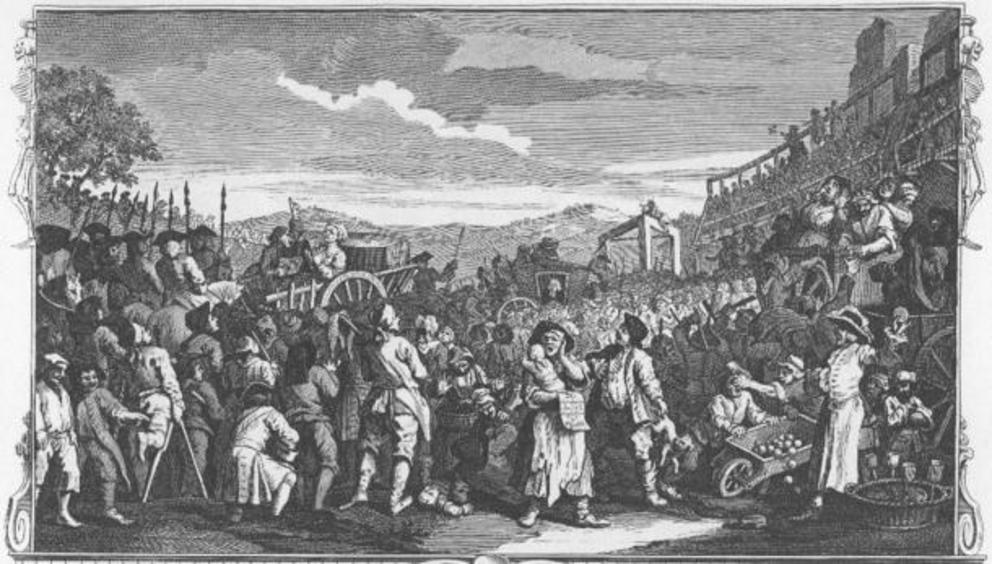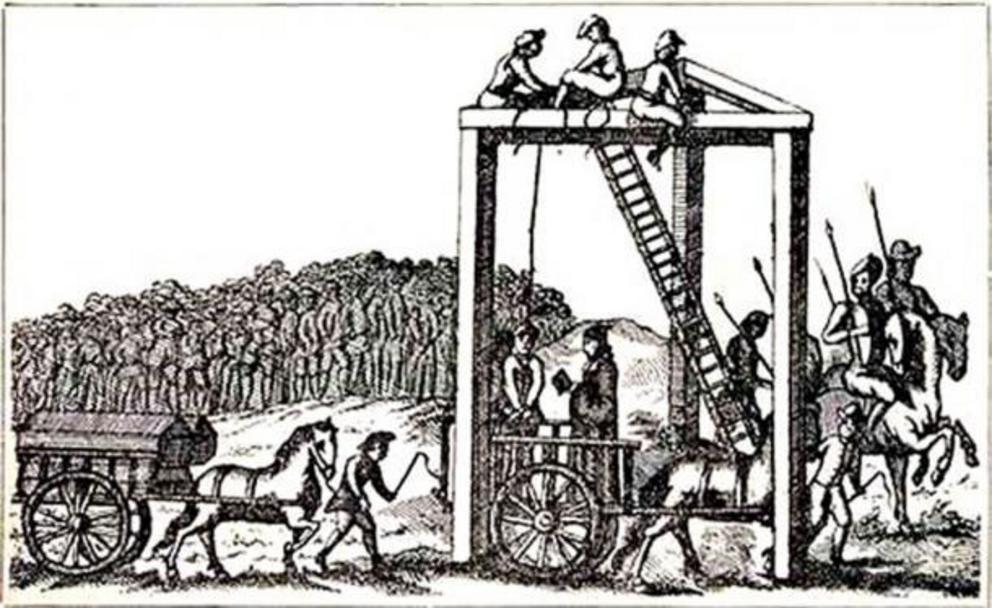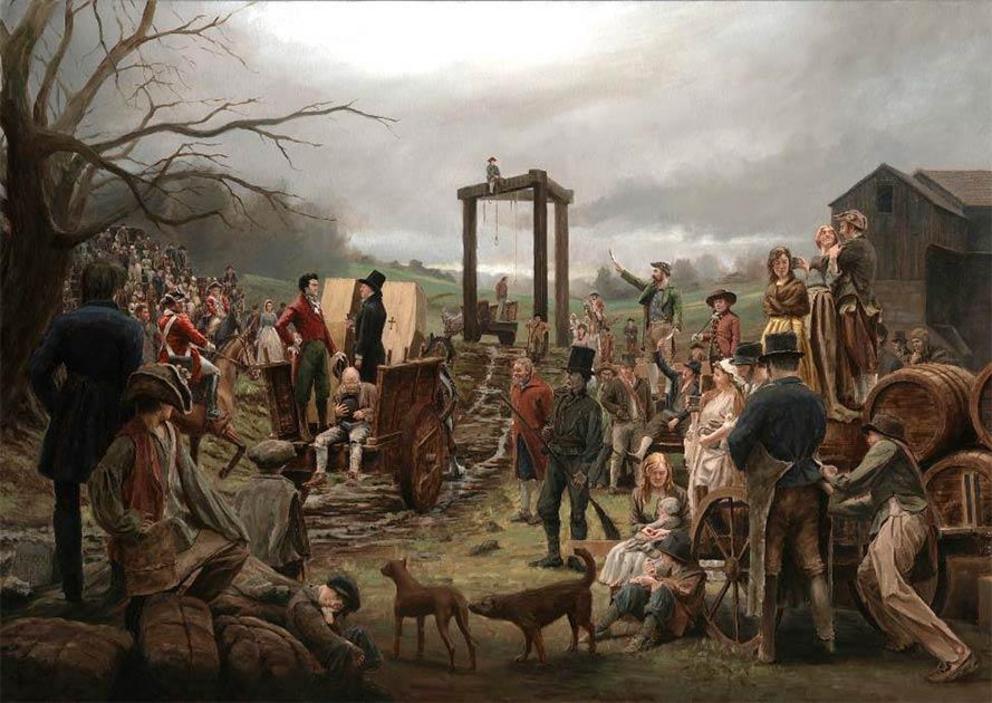The gruesome story of Tyburn Tree, London’s infamous gallows
Top Image: The Tyburn Tree by Wayne Haag from the Hyde Park Barracks Mural Project, Sydney, Australia.
In the modern day and age, crime is no less present than it was several hundred years ago. Sure, the world did become a lot more civilized, but criminals still exist. But the truth is, that while most crimes will certainly get a criminal into a whole lot of trouble, it will not be as bad as it was in ye olden days. Because in the 1600’s in England, even the smallest crime could cost you your life! From as early as the 1300’s and all the way to the end of the 1700’s, England – and especially its capital, London – were a real hive of crime and villainy. Imprisoning all these crime-loving perpetrators was certainly a challenging task, so it turned out to be easier to simply sentence them to death. This is where the famous Tyburn Tree comes in – a gallows that became one of London’s most macabre attractions.
The Origins of the Tyburn Gallows
Once upon a time, before the rapid expansion of the metropolis that is London, Tyburn was a village on its periphery. It once stood close to where the iconic Marble Arch is situated today and at the southern end of the Edgware Road. As a small hamlet, it boasted a lengthy history and some importance in England’s distant past. It was one of the two medieval manors of the parish Marylebone – which is now a part of Greater London too.
Plenty of evidence shows that Tyburn was a place of local significance even in ancient times. In the village, which grew at the crossroads of two important Roman roads , there stood an ancient standing stone. Known as Oswulf’s Stone , this menhir marked the area for many centuries.
 William Hogarth - Industry and Idleness, Plate 11; The Idle 'Prentice Executed at Tyburn.’
William Hogarth - Industry and Idleness, Plate 11; The Idle 'Prentice Executed at Tyburn.’
It was eventually buried in 1851 with the moving of the Marble Arch, but was dug up again a mere three years afterwards – as its historical value was recognized. For a short while this stone stood leaning on the Arch, but it has not been seen for many years now. It could have given us some very important information about Tyburn and its history.
But not to worry – the citizens of London and the whole of England made sure to give Tyburn a new face and a new history to echo through time. They did this with crime and death. From early medieval times, Tyburn became the location at which public executions took place.
The only method used on this spot was hanging, and throughout its history, this location close to the junction of Edgware Road and Oxford Street sported a macabre looking gallows pole. For centuries, it was the last stop for many a criminal, highwayman, thief, and traitor, before they would meet the great unknown.
Between roughly 1108 and 1783, the Tyburn gallows were the primary execution spot in London, but certainly not the only one. Around the 1500’s the gallows pole evolved – it was redesigned as a triangular, three post gallows, from which multiple criminals could be hanged at one time. From this point on, it became the iconic Tyburn Tree.
 An illustration, said to be from about 1680, of the permanent gallows at Tyburn.
An illustration, said to be from about 1680, of the permanent gallows at Tyburn.
Being a criminal in medieval England was certainly a popular calling, and surely a lucrative one. But getting caught red-handed meant that harsh punishment was guaranteed. Gibbers, stocks, lashings, and chains were a certainty for lesser offences, and death for harder ones. Trials were often prompt, and depending on the crime committed, death without pardon was oft declared.
And in these cases, Tyburn was most often the final destination. In time, this grim location in London acquired legendary status. Executions at the Tyburn Tree became true spectacles, attracting crowds that numbered thousands. Public executions were advertised days in advance, and were almost treated as holidays.
Workers and apprentices were given a day off on the execution day, and tickets were sold for raised seats to observe the hanging. As the population of London grew, so did the amount of crime, and so did the crowds to watch the events at Tyburn Tree. A particularly exciting execution would draw thousands of people, who would cheer the condemned or jeer at them. Numerous sources state that the executions would draw between 3,000 and 30,000 people, while the hanging of a particularly important person could attract close to 100,000 people.
Dancing the Tyburn Jig
‘To go west,’ ‘take a ride to the Tyburn,’ and ‘dance the Tyburn Jig’ became common expressions in London of the time. They were all euphemisms for death. But oddly enough, being hanged at Tyburn wasn’t as grim as you might think.
For aspiring criminals of the era, execution at the Tyburn Tree was sort of an acknowledgment of their status, so to speak. It was the crème de la crème of executions. And as much as it was a spectacle for the crowd, it was for the condemned too. They would put on their finest clothing and put on an act as well. A criminal was expected to give “a good death” to the crowd, and face the gallows with bravery and humor. Such a death would earn shouts of joy and acceptance from the gathered. In cases of fear or a “bad death”, those shouts would be jeers and hoots.
Most prisoners that were sentenced to death - if not all - were transported to Tyburn from the Newgate prison. After hearing their prayers, and receiving the sacrament if they wished to do so, the prisoner was then taken to the gallows in an open horse drawn cart. The procession was always followed by crowds of people, often making the progress slow and lasting many hours – even if the distance from Newgate to Tyburn was only 3 miles (4.8 km). The procession would stop at one of the inns along the way, usually the Bowl Inn at St Giles, where the condemned man was allowed to drink wine or strong liquor. Afterwards, it was time to dance one final, Tyburn jig.
Tyburn became the last stop for many notorious and infamous criminals of the era, most of which took on the form of folk heroes, loved by the poor classes of London who never truly liked the law. Jack Sheppard was one such man, known by the folk as Honest Jack.
 Sketch of 18th-century thief Jack Sheppard shortly before his execution in 1724.
Sketch of 18th-century thief Jack Sheppard shortly before his execution in 1724.
Born into a poor family and serving as a carpenter’s apprentice, Honest Jack soon saw that the woodworker’s trade wasn’t really for him. Instead, he turned to theft and burglary. Known to all as Gentleman Jack, Jack the Lad, and Honest Jack, he quickly became recognized for his crimes.
He was arrested five times and imprisoned each time, but managed to escape prison four times, using daring and unique methods. For these exploits, Jack the Lad became an almost legendary figure, and something of a folk hero for the poor classes.
Alas, greed got the better of Jack. In 1724, he robbed a pawnshop in Drury’s Lane, and dressed himself as a dandy gentleman. From the money he stole he spent the whole night with mistresses, until he was arrested while being absolutely blind drunk.
The Dashing Rogue Goes West
So famous was Gentleman Jack, that the jailers charged four shillings for anyone who wished to see him. And his execution was no less of a spectacle. On that day, when it was time for Jack to dance the Tyburn Jig, a crowd of 200,000 people gathered to witness it. At the time, that was a third of London’s entire population! The procession that took him to the gallows stopped on Oxford Street, at a tavern known as City of Oxford Inn. There, Jack drank a pint of sherry.
Meanwhile, at the Tyburn Gallows, a true carnival was happening. Sheppard’s semi-official autobiography was sold en-masse to the gathered crowd. Most agree that this “autobiography” was actually ghostwritten by the famous writer of the time Daniel Defoe. Even so, the 22-year-old Jack Sheppard couldn’t escape the hangman’s noose. He danced the Tyburn Jig.
It certainly isn’t a nice way to depart from this mortal coil while thousands of faces eagerly await to see you do so, cheering you on all the while. But many a thief and criminal found courage in it, smiling and cheering even as the noose was tightened around their neck. That is what happened for William Spiggot, a notorious highwayman and one of many who pestered rich folk on England’s roads.
During that period, highwaymen were a dime a dozen. They looked like normal citizens, but one thing separated them others – they robbed travelers they met on the road. Spiggot became notorious in London society for being a poacher, burglar, highway robber, and a murderer.
 ‘Claude Duval’ (1859), by Powell Frith in Manchester Art Gallery.
‘Claude Duval’ (1859), by Powell Frith in Manchester Art Gallery.
His exploits and notoriety made him another semi-legendary figure for the poor classes. Alas, that didn’t save him from justice, and he too ended up on the Tyburn Tree. Spiggot met his end thanks to one particular gentleman, the self-proclaimed Thief Taker General - Jonathan Wild.
The Final Decades of the Infamous Tyburn Tree
During his lifetime, Wild became a notorious figure of London’s society. Posing as a lawman and fighter against crime, Wild in fact benefited from both law and crime. As an infamous underworld figure, he ran a lucrative and major criminal empire, all the while acting as London’s foremost “thief taker” - a private individual employed to apprehend wanted criminals .
For Wild, this cover of crime fighting posed a great screen for his shady activities, such as bribery, theft, money laundering, fraud, and numerous other crimes. He would often steal valuable items, only to collect rewards offered for their return. As a thief taker, he would often apprehend his own criminal rivals, and efficiently remove his competition – all in a somewhat lawful manner. Arguably the most noted of the Thief Taker General’s arrests is that of the aforementioned folk hero, Gentleman Jack. For it was Wild who arrested him and sent him to Tyburn Tree.
But the old gallows pole does not differentiate between a lawman and a criminal. The noose is a universal tool – one size fits all! And so it was that even the notorious thief taker Jonathan Wild ended dancing the Tyburn Jig. Not long after his arrest of Jack Sheppard, the criminal activities that Wild was involved in all came to surface. His ex-accomplices turned against him, and soon enough, the man who had sent many a criminal to the Tyburn Tree ended up there himself.
 Gallows ticket for the hanging of Jonathan Wild.
Gallows ticket for the hanging of Jonathan Wild.
Almost 60 years later, the old Tyburn Tree would have its final victim. A murderer and a highwayman, John Austin, was hanged at the gallows on November 3rd, 1783, becoming the last ever person to meet that fate. The most likely reason for Tyburn’s retirement was the expansion of London as a city, and the focus on executions within the confines of the Newgate prison .
Today, the exact location of the Tyburn Tree is somewhat disputed, but the widely accepted site can be seen. It is situated in one of the busiest parts of London, at the junction of Oxford Street, Edgware Road, and Bayswater Road. The exact location is a traffic island, and is marked with a commemorative plaque and three young oak saplings – a metaphoric parallel to the three-posted gallows pole of the past. Contrary to the post that made up an instrument of death – today we have a symbol of life and flourishing: the young saplings.
 The stone commemorating the Tyburn Tree site on the traffic island at the junction of Edgware Road and Marble Arch.
The stone commemorating the Tyburn Tree site on the traffic island at the junction of Edgware Road and Marble Arch.
A Few Centuries of Grim Reputation
The Tyburn gallows were not the only ones in the London area, and certainly not in England of the medieval period and later. Such grim spots were to be found all over the realm, and acted as a certain symbol of power and dominance of regional lords and law-givers. Alas, England was also rife with criminals and miscreants of all kinds imaginable, which meant that the gallows were in frequent use. But none of these spots gained such a fearsome and long lasting reputation as the storied Tyburn Tree.

